Review of Research Status and Development Trends of Wireless Passive LC Resonant Sensors for Harsh Environments
Abstract
:1. Introduction
| Category | Characteristics | Typical Applications |
|---|---|---|
| Biomedical sensors | In vivo | Pressure monitoring in eyes, blood vessel, and abdominal aortic aneurysm, etc. |
| High-temperature sensors | −55 to 1500 °C | Aircrafts, engines, steel process control, and environmental monitoring |
| Humidity and gas sensors | Resistant to corrosion and high humidity | Harmful component monitoring in chemical plants, fuel cells, and packaged foods, etc. |
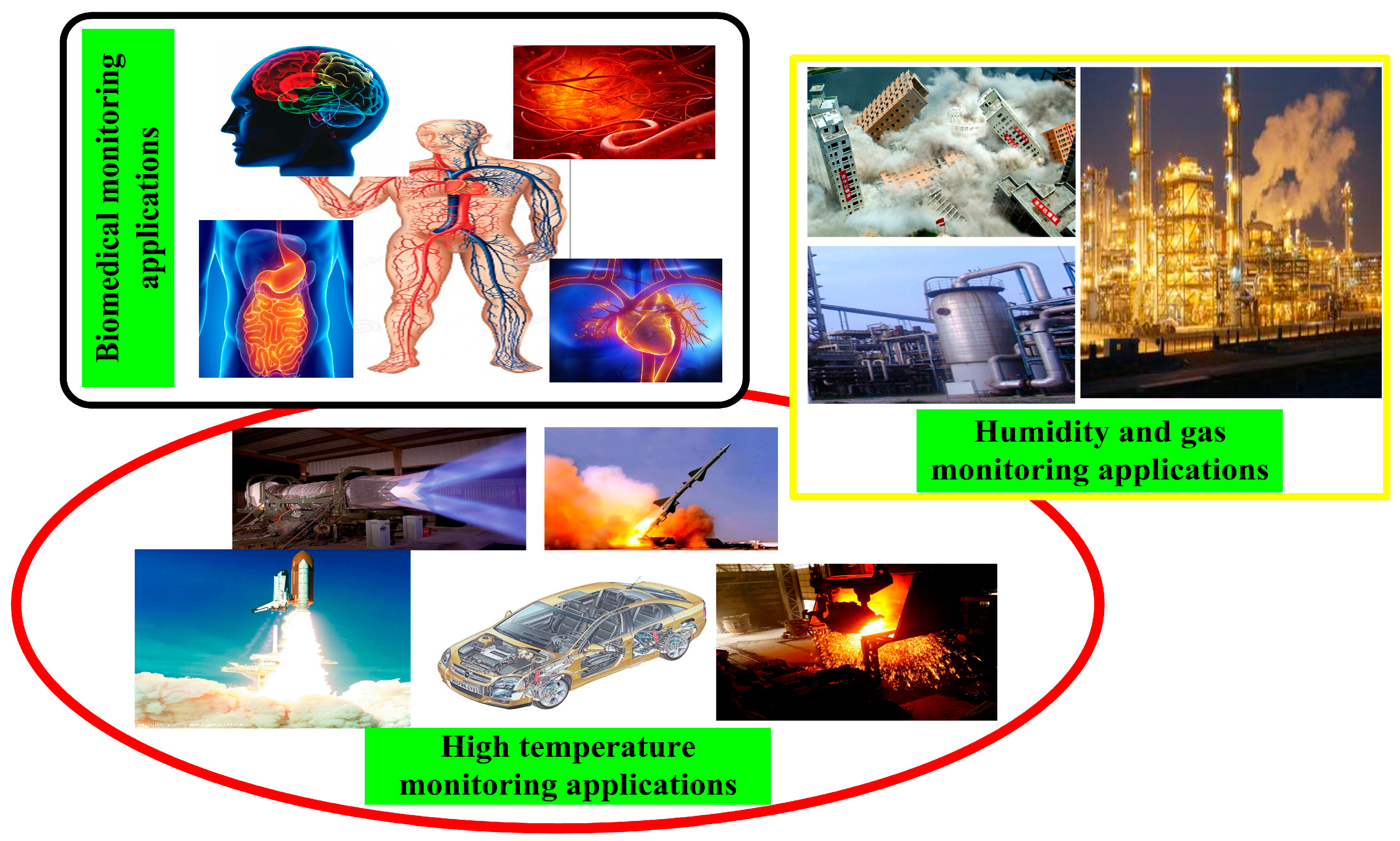
2. Wireless Measurement Principles and Sensor Design Model
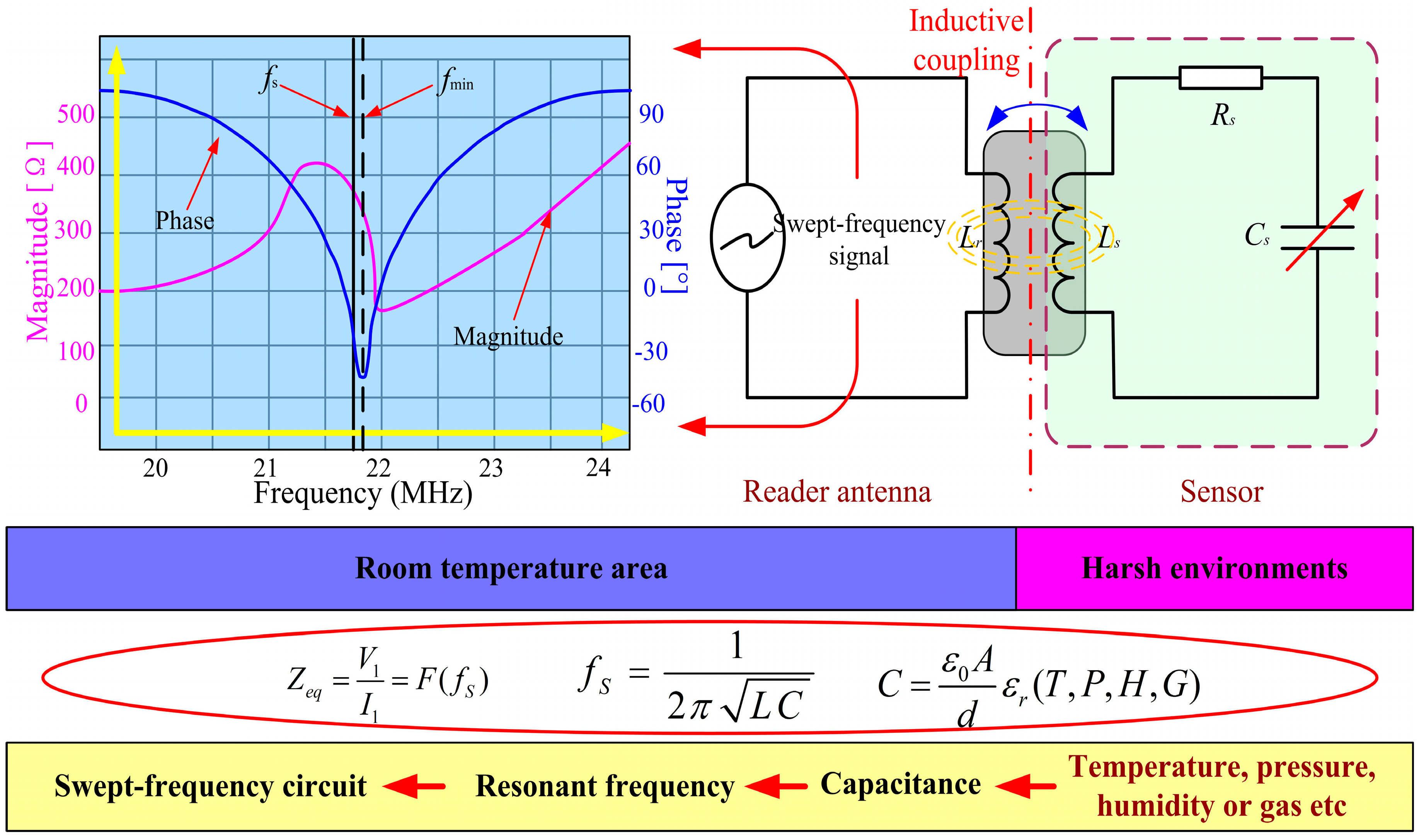
3. Research Status of Wireless Passive LC Sensors for Harsh Environments
3.1. High-Temperature Environments
3.1.1. High-Temperature Sensors for Pressure Measurements
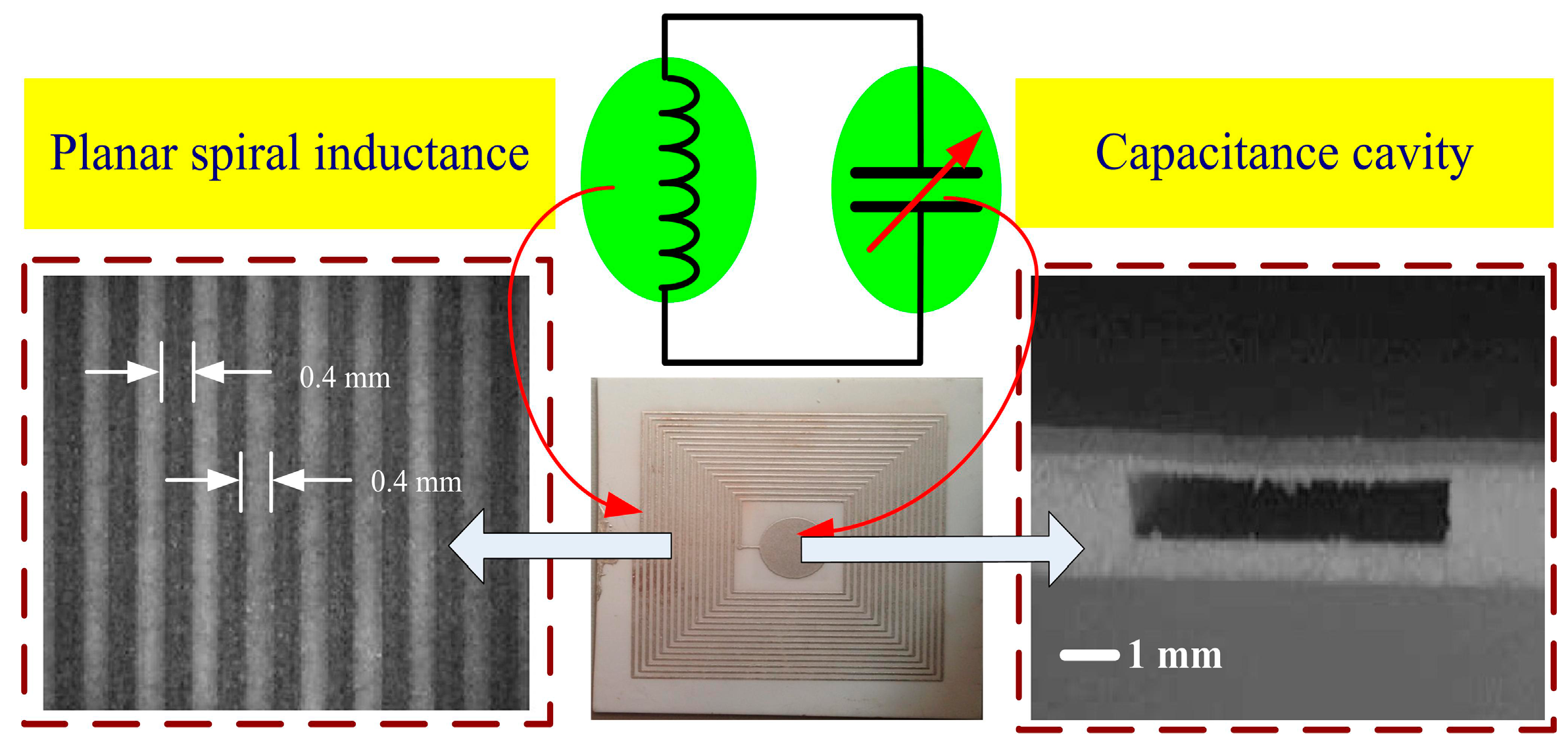
3.1.2. High-Temperature Sensors for Temperature Measurement
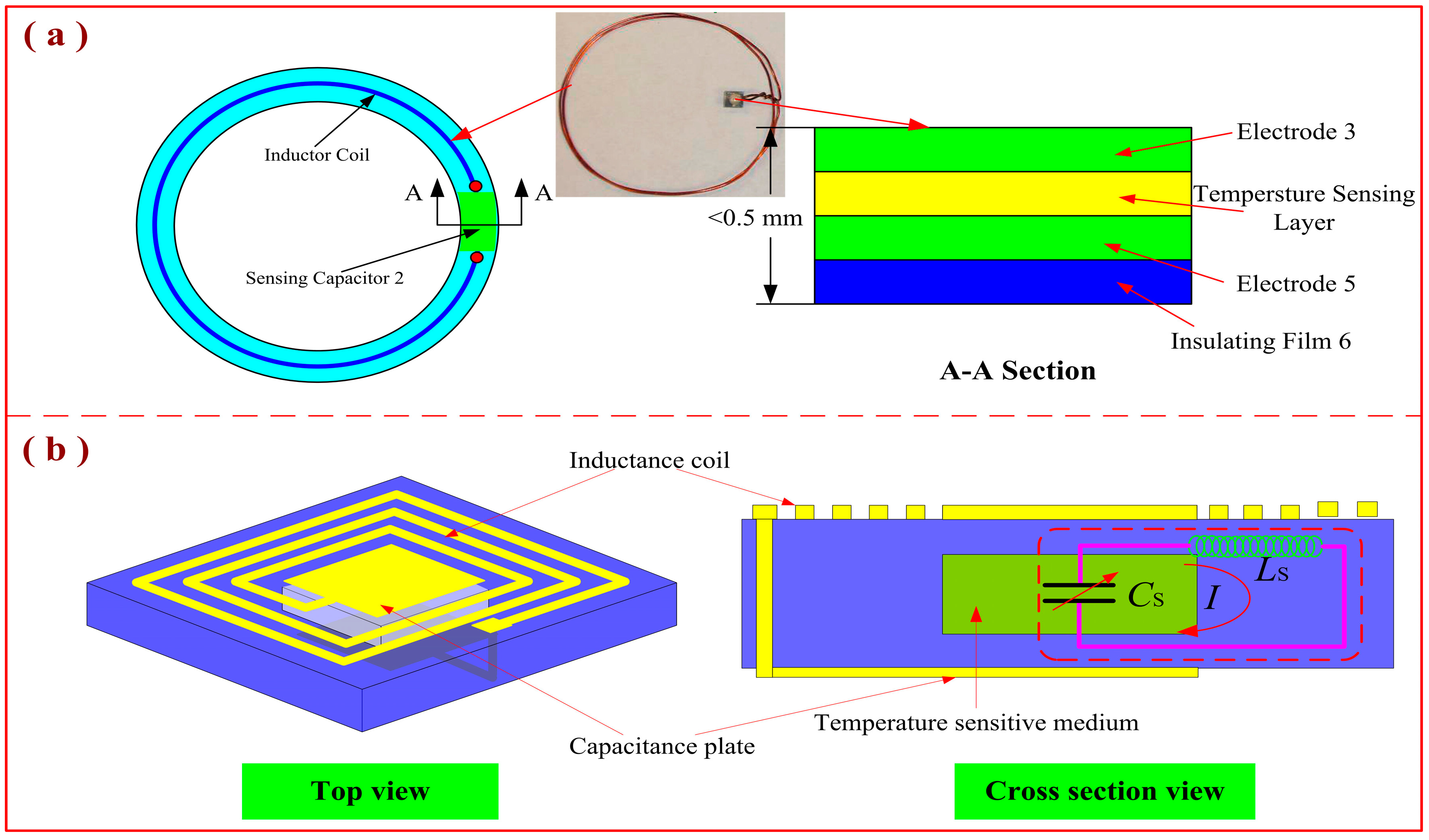
3.2. Biomedical Environments
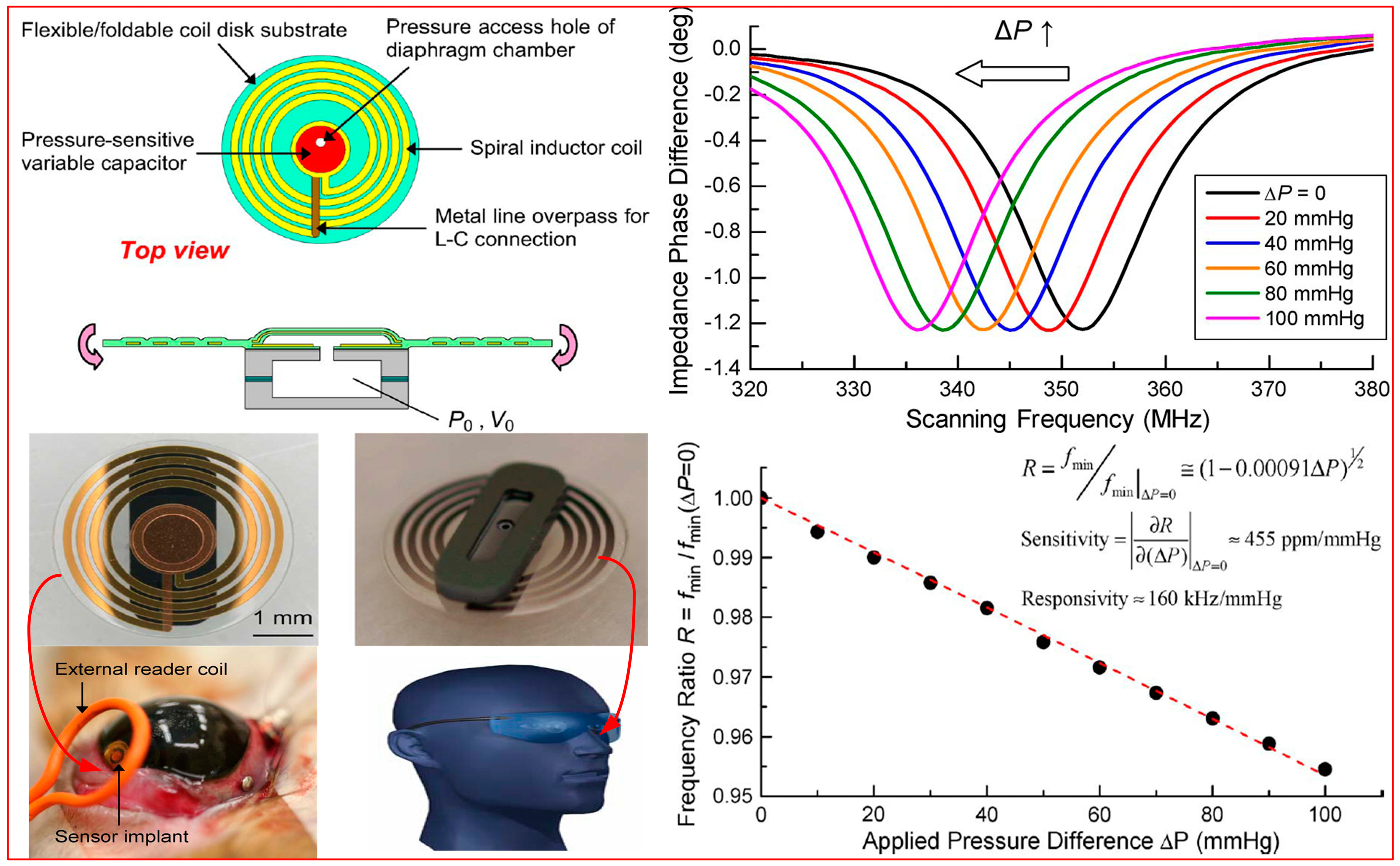
3.3. Harmful Components of Harsh Environments
3.3.1. Humidity Monitoring
3.3.2. Gas Monitoring
4. Development Trends of Passive LC Sensors
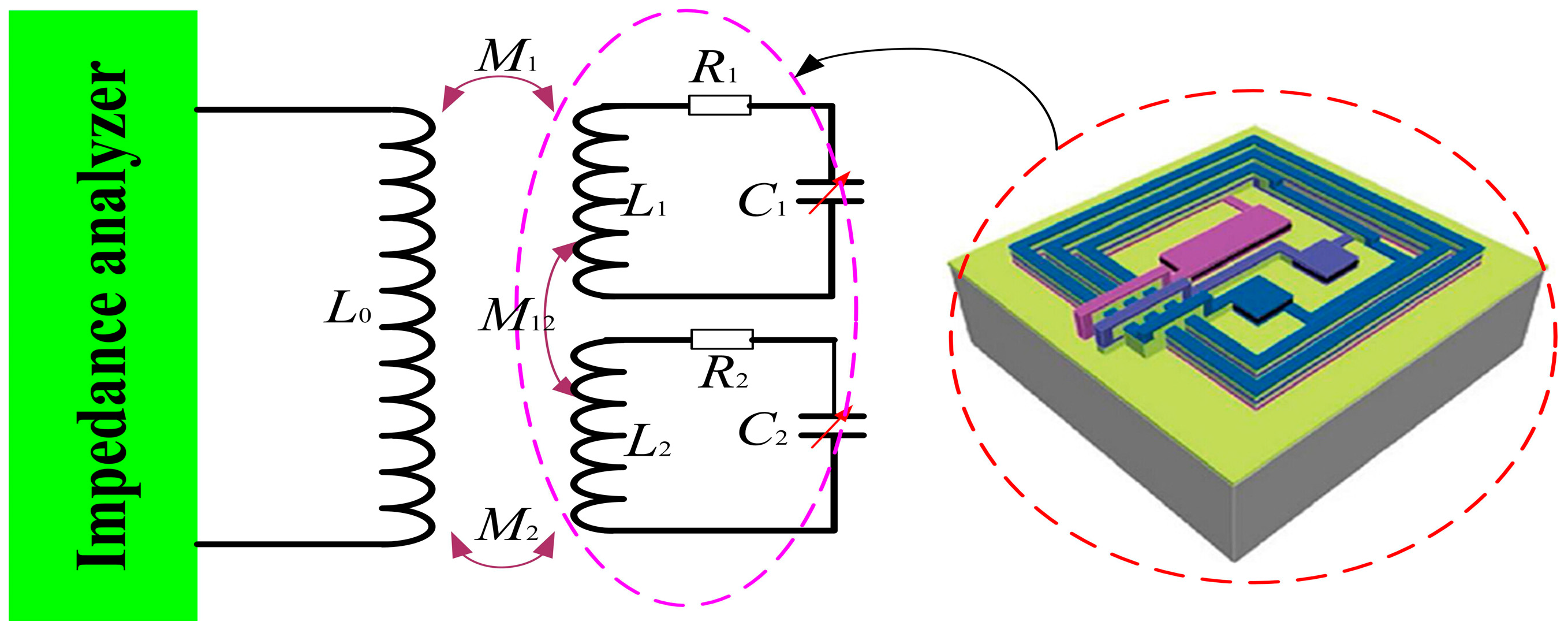
5. Conclusions
Acknowledgments
Author Contributions
Conflicts of Interest
References
- Johnson, R.W.; Evans, J.L.; Jacobsen, P.; Thompson, J.R.; Christopher, M. The changing automotive environment: High-temperature electronics. IEEE Trans. Electron. Packag. Manuf. 2004, 27, 164–176. [Google Scholar] [CrossRef]
- George, T.; Son, K.A.; Powers, R.A.; del Castillo, L.Y.; Okojie, R. Harsh environment microtechnologies for NASA and terrestrial applications. In Proceedings of the IEEE Sensors, Irvine, CA, USA, 30 October 2005; pp. 1253–1258.
- Werner, M.R.; Fahrner, W.R. Review on materials, microsensors, systems and devices for high-temperature and harsh-environment applications. IEEE Trans. Ind. Electron. 2001, 48, 249–257. [Google Scholar] [CrossRef]
- Beeby, S.; Ensell, G.; Kraft, M.; White, N. MEMS Mechanical Sensors; Artech House, Inc.: Boston, MA, USA, 2004. [Google Scholar]
- Viikari, V.; Song, J.S.; Seppa, H. Passive wireless sensor platform utilizing a mechanical resonator. IEEE Sens. J. 2013, 13, 1180–1186. [Google Scholar] [CrossRef]
- Viikari, V.; Seppa, H.; Kim, D.K. Intermodulation read-out principle for passive wireless sensors. Microw. Theory Tech. 2011, 59, 1025–1031. [Google Scholar] [CrossRef]
- Song, J.S.; Viikari, V.; Pesonen, N.; Marttila, I.; Seppa, H. Optimization of wireless sensor based on intermodulation communication. Microw. Theory Tech. 2013, 61, 3446–3452. [Google Scholar] [CrossRef]
- Fonseca, M.A.; English, J.M.; Arx, M.; Allen, M.G. Wireless micromachined ceramic pressure sensor for high-temperature applications. J. Microelectromechan. Syst. 2002, 11, 337–343. [Google Scholar] [CrossRef]
- Nopper, R.; Niekrawietz, R.; Teindl, L. Wireless readout of passive LC sensors. IEEE Trans. Instrum. Meas. 2010, 59, 2450–2457. [Google Scholar] [CrossRef]
- Wheeler, H.A. Simple inductance formulas for radio coils. Proc. Inst. Radio Eng. 1928, 16, 1398–1400. [Google Scholar] [CrossRef]
- Mohan, S.S.; Hershenson, M.D.; Boyd, S.P.; Lee, T.H. Simple accurate expression for planar spiral inductances. IEEE J. Soild-State Circuits 1999, 34, 1419–1424. [Google Scholar] [CrossRef]
- Zhai, J.; How, T.V.; Hon, B. Design and modeling of a passive wireless pressure sensor. CIRP Ann. Manuf. Technol. 2010, 59, 187–190. [Google Scholar] [CrossRef]
- English, J.M.; Allen, M.G. Wireless micromachined ceramic pressure sensors. In Proceedings of the Twelfth IEEE Micro-electro-mechanical Systems Conference, Orlando, FL, USA, 21 January 1999; pp. 511–516.
- Fonseca, M.A. Polymer/Ceramic Wireless MEMS Pressure Sensors for Harsh Environments: High Temperature and Biomedical Applications. Ph.D Thesis, Georgia Institute of Technology, Atalanta, GA, USA, 2007. [Google Scholar]
- Birdsell, E.D.; Park, J.; Allen, M.G. Wireless ceramic sensors operating in high temperature environment. In Proceedings of the 40th ALAA/ASME/SAE/ASEE Joint Propulsion Conference, Fort Lauderdale, FL, USA, 11 July 2004.
- Radosavljevic, G.; Zivanov, L.J.; Smetana, W.; Maric, A.; Unger, M.; Nad, L. A wireless embedded resonant pressure sensor fabricated in the standard LTCC technology. IEEE Sens. J. 2009, 9, 1956–1962. [Google Scholar] [CrossRef]
- Radosavljevic, G.; Smetana, W.; Mari, A.; Zivanov, L.J.; Unger, M.; Stojanovi, G. Microforce sensor fabricated in the LTCC Technology. In Proceedings of the 27th International Conference on Microelectronics (MIEL 2010), Nis, Serbia, 16–19 May 2010; pp. 16–19.
- Xiong, J.J.; Li, Y.; Hong, Y.P.; Zhang, B.Z.; Cui, T.H.; Tan, Q.L.; Zheng, S.J.; Liang, T. Wireless LTCC-based capacitive pressure sensor for harsh environment. Sens. Actuators A 2013, 197, 30–37. [Google Scholar] [CrossRef]
- Xiong, J.; Zheng, S.; Hong, Y.; Li, J.; Wang, Y.; Wang, W.; Tan, Q. Measurement of wireless pressure sensors fabricated in high temperature co-fired ceramic MEMS technology. J. Zhejiang Univ. Sci. C (Comput. Electron.). 2013, 14, 258–263. [Google Scholar] [CrossRef]
- Zheng, S.J.; Liang, T.; Hong, Y.P.; Xiong, J.J. Fabrication and measurement of wireless pressure-sensitive micro-device based on high temperature cofired ceramics technology. Sens. Rev. 2014, 34, 117–122. [Google Scholar] [CrossRef]
- Li, C.; Tan, Q.L.; Xiong, J.J.; Jia, P.G.; Hong, Y.P.; Ren, Z.; Luo, T.; Liu, J.; Xue, C.Y.; Zhang, W.D. A noncontact wireless passive radio frequency (RF) resonant pressure sensor with optimized design for applications in high-temperature environment. Meas. Sci. Technol. 2014, 25, 075101. [Google Scholar] [CrossRef]
- Li, C.; Tan, Q.L.; Zhang, W.D.; Xue, C.Y.; Li, Y.Z.; Xiong, J.J. Microfabrication of a novel ceramic pressure sensor with high sensitivity based on low-temperature co-fired ceramic (LTCC) technology. Micromachines 2014, 5, 396–407. [Google Scholar] [CrossRef]
- Tan, Q.L.; Kang, H.; Xiong, J.J.; Qin, L.; Zhang, W.D.; Li, C.; Ding, L.Q.; Zhang, X.S.; Yang, M.L. A wireless passive pressure microsensor fabricated in htcc mems technology for harsh environments. Sensors 2013, 13, 9897–9908. [Google Scholar] [CrossRef] [PubMed]
- Tan, Q.L.; Qin, L.; Kang, H.; Xiong, J.J.; Zhang, W.D.; Luo, T.; Li, C.; Ding, L.Q.; Zhang, X.S.; Yang, M.L. Zirconia ceramics applied in a pressure-sensitive device fabricated using HTCC technology. Sens. Mater. 2014, 1, 19–30. [Google Scholar]
- Luo, T.; Tan, Q.L.; Ding, L.Q.; Wei, T.Y.; Li, C.; Xue, C.Y.; Xiong, J.J. A passive pressure sensor fabricated by post-fire metallization on zirconia ceramic for high-temperature applications. Micromachines 2014, 5, 814–824. [Google Scholar] [CrossRef]
- Tan, Q.L.; Yang, M.L.; Luo, T.; Liu, W.; Li, C.; Xue, C.Y.; Liu, J.; Zhang, W.D.; Xiong, J.J. A novel interdigital capacitor pressure sensor based on LTCC technology. J. Sens. 2014, 2014. [Google Scholar] [CrossRef]
- Wang, Y.; Jia, Y.; Chen, Q.S.; Wang, Y.Y. A passive wireless temperature sensor for harsh environment applications. Sensors 2008, 8, 7982–7995. [Google Scholar] [CrossRef]
- Tan, Q.L.; Luo, T.; Xiong, J.J.; Kang, H.; Ji, X.X.; Zhang, Y.; Yang, M.L.; Wang, X.L.; Xue, C.Y.; Liu, J.; Zhang, W.D. A harsh environment-oriented wireless passive temperature sensor realized by LTCC technology. Sensors 2014, 14, 4154–4166. [Google Scholar] [CrossRef] [PubMed]
- Tan, Q.L.; Ren, Z.; Cai, T.; Li, C.; Zheng, T.L.; Li, S.N.; Xiong, J.J. Wireless passive temperature sensor realized on multilayer HTCC tapes for harsh environment. Available online: http://www.hindawi.com/journals/js/aa/124058 (accessed on September 2014).
- Chen, P.J.; Rodger, D.C.; Saati, S.; Humayun, M.S.; Tai, Y.C. Microfabricated implantable parylene-based wireless passive intraocular pressure sensors. J. Microelectromec. Syst. 2008, 17, 1342–1351. [Google Scholar] [CrossRef]
- Chen, P.J.; Saati, S.; Varma, R.; Humayun, M.S.; Tai, Y.C. Wireless intraocular pressure sensing using microfabricated minimally invasive flexible-coiled LC sensor implant. J. Microelectromec. Syst. 2010, 19, 721–734. [Google Scholar] [CrossRef]
- Chitnis, G.; Maleki, T.; Samuels, B.; Cantor, L.B.; Ziaie, B. A minimally invasive implantable wireless pressure sensor for continuous lOP monitoring. IEEE Trans. Biomed. Eng. 2013, 60, 250–256. [Google Scholar] [CrossRef] [PubMed]
- Xue, N.; Chang, S.P.; Lee, J.B. A SU-8 based microfabricated implantable inductively coupled passive RF wireless intraocular pressure sensor. J. Microelectromec. Syst. 2012, 21, 1338–1364. [Google Scholar] [CrossRef]
- Shi, Q.; Wang, J.B.; Chen, D.; Chen, J.; Li, J.; Bao, K. In vitro and In vivo characterization of wireless and passive micro system enabling gastrointestinal pressure monitoring. Biomed. Microdevices 2014, 16, 859–868. [Google Scholar] [CrossRef] [PubMed]
- Chen, G.Z.; Chan, L.S.; Lam, D. Capacitive contact lens sensor for continuous non-invasive intraocular pressure monitoring. Sens. Actuators A. 2013, 203, 112–118. [Google Scholar] [CrossRef]
- Bao, K.K.; Chen, D.Y.; Shi, Q.; Liu, L.J.; Chen, J.; Li, J.; Wang, J.B. A readout circuit for wireless passive LC sensor and its application for gastrointestinal monitoring. Meas. Sci. Technol. 2014, 25, 85104–85111. [Google Scholar] [CrossRef]
- Stojanovic, G.; Radovanovic, M.; Malesev, M.; Radonjanin, V. Monitoring of water content in building materials using a wireless passive sensor. Sensors 2010, 10, 4270–4280. [Google Scholar] [CrossRef] [PubMed]
- Tan, E.L.; Ng, W.N.; Shao, R.Y.; Pereles, B.D.; Ong, K.G. A wireless passive sensor for quantifying packaged food quality. Sensors 2007, 7, 1747–1756. [Google Scholar] [CrossRef]
- Ong, J.B.; You, Z.P.; Mills-Beale, J.; Tan, E.L.; Pereles, B.D.; Ong, K.G. A wireless passive embedded sensor for real-time monitoring of water content in civil engineering material. IEEE Sens. J. 2008, 8, 2053–2058. [Google Scholar] [CrossRef]
- Ong, K.G.; Zeng, K.; Grimes, C.A. A wireless, passive carbon nanotube-based gas sensor. IEEE Sens. J. 2002, 2, 82–88. [Google Scholar]
- Ong, K.G.; Zeng, K.; Grimes, C.A. A carbon nanotube-based sensor for CO2 monitoring. Sensors 2001, 1, 193–205. [Google Scholar] [CrossRef]
- Ling, Y.F.; Zhang, H.; Gu, G.R.; Lu, X.J.; Kayastha, V.; Jones, C.S.; Shih, W.-S.; Jazon, D.C. A printable CNT-based FM passive wireless sensor tag on a flexible substrate with enhanced sensitivity. IEEE Sens. J. 2013, 2, 2546–2550. [Google Scholar] [CrossRef]
- Zhang, C.; Hang, J.Q.; Hang, Q.A. Design of LC-type passive wireless multi-parameter sensor. In Proceedings of the Nano/Micro Engineered and Molecular Systems (NEMS), Suzhou, China, 7–10 April 2013; pp. 256–259.
© 2015 by the authors; licensee MDPI, Basel, Switzerland. This article is an open access article distributed under the terms and conditions of the Creative Commons Attribution license (http://creativecommons.org/licenses/by/4.0/).
Share and Cite
Li, C.; Tan, Q.; Jia, P.; Zhang, W.; Liu, J.; Xue, C.; Xiong, J. Review of Research Status and Development Trends of Wireless Passive LC Resonant Sensors for Harsh Environments. Sensors 2015, 15, 13097-13109. https://doi.org/10.3390/s150613097
Li C, Tan Q, Jia P, Zhang W, Liu J, Xue C, Xiong J. Review of Research Status and Development Trends of Wireless Passive LC Resonant Sensors for Harsh Environments. Sensors. 2015; 15(6):13097-13109. https://doi.org/10.3390/s150613097
Chicago/Turabian StyleLi, Chen, Qiulin Tan, Pinggang Jia, Wendong Zhang, Jun Liu, Chenyang Xue, and Jijun Xiong. 2015. "Review of Research Status and Development Trends of Wireless Passive LC Resonant Sensors for Harsh Environments" Sensors 15, no. 6: 13097-13109. https://doi.org/10.3390/s150613097






